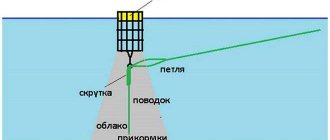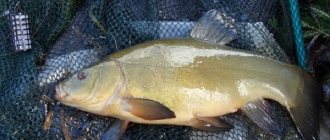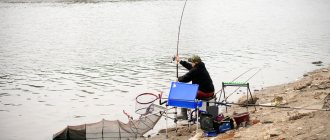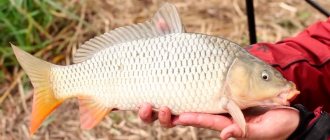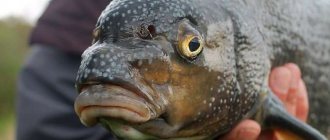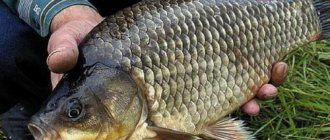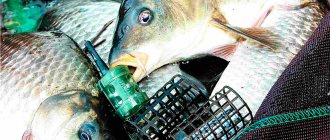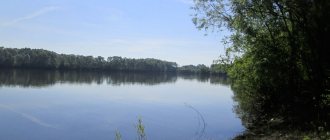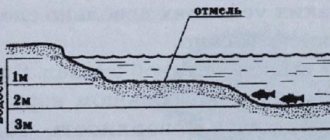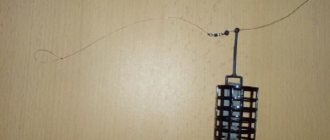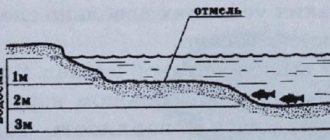Nikolay Linnik | August 15, 2021
Here in Belarus, as a rule, sabrefish are hunted with a sbirulino float, but at certain moments this fish is for some reason better caught not in the surface layers, but with a classic feeder.
And in order to end up with a catch, you have to quickly rebuild your fishing strategy, while little things and nuances that you would not have paid attention to at other times can play a key role in the success of your fishing. I'll tell you about these little things.
Chekhon of the Pripyat River
Chekhon feels great in this river of ours, actively reproduces and can reach very impressive sizes - my personal record is 67 cm. But usually the catches are dominated by fish 30 - 40 cm long.
In the spring, before spawning (and Pelecus cultratus spawns in our area in early May) and immediately after it, most often saberfish can be found on sandy beaches and river spits. And when the river returns to its channel, it goes to the deepest sections of the river with a strong current, where it stays until autumn.
Chekhon is a schooling fish. And the more solid the flock, the greater the chances of a stable bite. Usually, no bait is required - the sabrefish, in the fight for food, rushes at everything that comes into its field of vision. Therefore, when catching sabrefish using a sbirulino float, they even use just bunches of red thread as bait.
Well, more often - a bunch of maggots, small twisters, fly fishing flies. But sabrefish are caught on the feeder as bycatch. And when you aim to catch a large bream, its bites are very annoying. It is not always possible to react in time to the sharp twitching of the quivertype at the moment when the feeder is just sinking to the bottom with heavy tackle. And if you don’t pay attention to these “twitches”, the bait on the hook, as a rule, turns out to be chewed - and the bream simply does not react to it.
But on days when bream refuses to bite, it makes sense to engage in feeder fishing for sabrefish purposefully. It's just not very easy to do. I experimented a lot, trying to adapt the feeder for this purpose: I installed the lightest feeders, lengthened the leash, and even hung an additional polystyrene ball near the hook.
However, fishing with sbirulino still turned out to be more effective. But the experiments continued. Slowly I began to understand the technique of presenting bait - and the puzzle came together. Feeder gear turned out to be especially effective on days when there were few flying insects above the water, so saberfish did not feed in the upper layers of water.
Method of catching sabrefish on a feeder
Fishing for Chekhoni on a feeder differs from fishing for other carp using such equipment, because this fish leads a more active lifestyle and feeds mainly in schools. If we are catching sabrefish, then casting the feeder with feeder equipment should be frequent, since the bite occurs mainly at the moment the load with bait is lowered.
Fishermen use commercial bait or make it themselves. The finished mixture should not be very moist and there is no need to use adhesive components in its composition so that the food is washed out well when the load is lowered to the bottom. Water for mixing is used from the same reservoir where the fishing will take place. The composition of the bait includes:
- corn flour;
- bran;
- crushed crackers;
- powdered milk;
- aromatics;
- chopped worms;
- maggot (best pupated).
If the desired sabrefish bite does not occur within about 20 minutes, it is better to change the fishing location or try changing the bait. A good result will depend on the use of different attachments on one hook. The bite of sabrefish is fast, swift, reminiscent of a chub.
Equipment requirements
If you want to target sabrefish using a feeder, you will need a high-quality lightweight rod. The rod with which bream is caught (usually with a test weight of 80 - 120 g) turns out to be too rough for high-speed fishing of sabrefish. When biting, the fish immediately feels resistance and throws the bait. Although the fisherman sees a bite (several distinct pokes), it usually never comes to an effective hook.
Most often I use two models of rods, both of them are 3.3 m long, but they differ in construction and test. One model (to be specific - Team Salmo Dominant , test up to 40 g) is softer, and it is convenient to fish with it when you find a large school of sabrefish, so no special accuracy is required in casting. But when fishing conditions are such that you need to hit some local point with the feeder, I use the tougher Pride MC model with a dough of up to 50 g and good accuracy of “shooting”.
When biting, the graceful blanks of these pickers load very smoothly - and the fish have enough time to swallow the bait. And how they work when fishing! Chekhon is desperately fighting for its life - and if the gear is set up incorrectly, gatherings near the shore are a very frequent occurrence. At one time I tried to work part-time as a reel clutch, but the jerks of the sabrefish are always so lightning fast that it is simply impossible to manage to adjust the optimal braking force by quickly rotating the brake adjuster. But with a light rod, the problem is solved very simply: the fish “rides” on it, as if the rig has a life-saving feeder - and comes to the shore completely tired. I just have to take it in my hand.
In addition to the fishing rod, you will need a stable tripod or stand with a long soft stand. And even if such equipment does not look like a river, but with a wide stand it is extremely convenient to hook if the bite occurs at the moment when the feeder is just lowering in the water column. And when fishing for sabrefish, such bites happen quite often.
Features of catching sabrefish on a feeder
Fishing for sabrefish occurs mainly in the middle and upper water line. When it gets colder, the fish sink to the lower layer closer to the pits and bottom. A device for catching sabrefish requires the presence of a hook and a feeder on a leash. If fishing occurs with the help of a feeder, then a rod with a length of at least 3.5 m is used. A shorter length will affect the quality of casting the tackle. The tackle includes the following elements:
- mandatory fishing rod;
- high quality reel;
- strong fishing line;
- convenient feeder;
- simple swivel;
- strong hooks;
- sensitive leash.
The weight of the reel depends on the speed of the current; the faster it is, the more solid it should be. Throwing the feeder needs to be done more often. Maggots, corn flour, worms and bran are used for bait. If there are no signs of biting within 20 minutes, you need to change the location and throw the feeder again. The sabrefish swallows the bait deeply and in order to make it easy to get the hook, a special device is used.
Feeder fishing involves casting over decent distances. The reel should be of medium size, and the rod itself should be slightly longer than the standard length. To ensure that there is no bait at the bottom of the reservoir, a floating fishing line is used, which is attached to a leash. If necessary, you can use foam to lighten it. It is recommended to have hooks whose points are visually bent inwards.
Coil
And here I had to experiment a lot. Conventional spinning models can also be considered as a reel for catching sabrefish using bottom gear, but in reality their brake settings turn out to be too rough - and this causes a lot of fish escapes.
Match reels with a large spool usually have a soft drag, but are too heavy. And with constant swinging of the rod, a few “extra” tens of grams turn into kilograms by the end of fishing. Match reels with a large gear ratio and a small spool for a feeder, even a light one, turn out to be too gentle.
In the end, I opted for an Allux , equipped with a lever for instant brake locking. By pressing this lever with my index finger, I can very smoothly and quickly adjust the braking force in the process of hooking and landing fish.
Main line
I use only monofilament as my main fishing line for saberfish. Unlike non-stretch braid, monofilament line gives me an additional advantage when landing fish. And it makes much less noise through the rings than the cord. It would seem like a trifle? But saberfish have good hearing, and are very wary of any extraneous noise.
When fishing near the shore, the quietness of the monofilament line allows me to see several dozen additional bites. Chekhon, although it resists fiercely, does not shine with outstanding dimensions, so for catching it, a fishing line with a diameter of 0.2 mm is quite enough.
Feeder
For our purposes, models with a large cell container and a flat bottom are better suited. Such feeders are freed from food faster than others, and when reeling out the gear, the flat bottom creates additional lifting force in the water - and the feeder quickly reaches the upper layers of the water. The optimal weight of feeders is in the range of 20 - 30 g.
Attempts to install lighter models led to an increase in the number of bleak bites.
Installation of equipment
Here I also had to try to find something suitable. For catching sabrefish, all loop mounting options turned out to be too “short” - the fish quickly felt the weight of the feeder and managed to spit out the hook even before hooking. The solution was found after I started using in-line . The clip-on feeder moves freely along the main line, so when biting the fish practically does not feel the weight of the feeder. And I always have a few extra seconds to make the hook.
The diameter of the leash line ranges from 0.12 – 0.14 mm. The leash itself is not always long; its dimensions have to be adjusted on each fishing trip. When starting fishing with a meter-long leash, I gradually shorten it, ensuring that when the fish bites, they swallow the bait shallowly.
Catching sabrefish with an elastic band
One of the popular ways for fishermen to catch saberfish is with a rubber band tackle. It is made from the following elements:
- reel;
- cargo;
- rubber;
- main line;
- safety line;
- winding ring;
- rope;
- fishing line for leashes;
- swivels with clasps;
- hooks
At the beginning of making the tackle, a small piece of rope is attached to the load for convenient throwing it into the water. A safety line or rope is attached to a separate mount. Using an auxiliary fishing line will make it possible to pull out the load without loss at the end of fishing. Then the elastic band is attached with one end to the weight and the other to the winding ring, to which a swivel with a clasp is attached. Next, they install the fishing line with leashes, the size of which will be from 25 to 40 cm. The number of leashes can be at your discretion from 2 to 10 pieces. The next process is to attach the main fishing line to the swivel. We select sharp hooks No. 6, preferably with a curved shank. We wind the main fishing line on the reel and the tackle is ready.
Hooks
The saberfish has a large mouth and can swallow bait deeply. But with an active bite, tearing the hook out of the fish’s throat every time is not a very pleasant task. So I select hooks depending on the desired size of the trophy. But we shouldn’t increase the size of the hook too much if we’re fishing with maggots or casters - this bait looks unnatural on a large hook.
After trying various options, I settled on two models of hooks Nos. 10-12: Colmic B957 and Kamasan B511 .
How to fish with a feeder rig
Bottom feeder gear has long proven itself well. With its help, various types of fish such as carp, bream, crucian carp, roach, grass carp, silver carp, and sabrefish are successfully caught. But for each of them, equipment is definitely selected according to the load, the length and number of branch leads, and the use of different baits and attachments.
Feeder equipment for catching saberfish includes the following components:
- feeder rod;
- inertia-free coil;
- main line;
- feeder;
- swivel;
- diverter leash or leashes;
- hooks
The reel is used with an average size of 4000. The main line used is 0.14-0.18 microns, it is not recommended to install thicker as it may affect the casting distance of the feeder with bait. Experienced fishermen have determined by practical methods that sabrefish do not respond to changes in the thickness of the fishing line on leashes.
Feeders are used for catching sabrefish using feeder equipment shipped depending on the characteristics of the reservoir on which it will be used. The faster the current in the chosen fishing spot, the heavier the feeder should be so that it does not drift along the bottom. When installing equipment for attaching a feeder, it is best to use a carabiner (American), which will allow you to quickly change feeders. In slow currents or in standing water, lighter “kormak” are used to slowly sink them to the bottom, while the bait will be distributed in the upper and middle water layers, where saberfish feed.
Lure
The saber fish responds best to active bait that is clearly visible in the water. For the names of mixtures such as “Bream”, “Roach”, etc. I haven't been paying attention for a long time. And from the arsenal of dry mixes I have, I chose Sensas Gros Gardons . This choice is not at all accidental. After all, the main thing is that the mechanical properties of the finished product are suitable for the fishing strategy I have planned. And here a significant role is played by how much water the dry mixture can “drink.”
The more water it absorbs during mixing, the easier it is to simulate the properties of the finished product. Sensas baits from this series absorb water very well. With leisurely repeated soaking and thorough mixing of the bait with your hands, sometimes additional punching through the sieve is not required - the final product is obtained without a single lump. When mixing the bait, I try to get a crumbly mixture that is easily washed out of the feeder.
I achieve this by gradually soaking with small volumes of water. Initially, about 300 ml of water is added to the dry mixture. The bait is mixed well and left to ripen for about 20 minutes. Then water is added in small portions, the mixture is again thoroughly mixed by hand. At the same time, I constantly monitor that the bait always remains a little dry. As a result, the entire kneading process takes at least half an hour.
To make the bait even more noticeable, I add a handful of two-color pastoncino biscuit crumbs to it. In addition to the plant base, my bait for catching sabrefish always contains maggots, casters, chopped worms and bloodworms.
One fishing session on the Pripyat River
After the starting feeding (which is 6 - 8 balls of bait the size of an apple), which I produced using a large slingshot, the bites began almost immediately. On this day, the saberfish attacked the bait not in the water column, but in the first 20 - 30 seconds after the feeder began to roll along the bottom under the influence of the current.
To maintain the fish's appetite at the proper level, every 10 - 15 minutes I put another ball of bait the size of a large apple into the water. If no bites occurred, I quickly reeled out the tackle and reloaded it with a fresh portion of food. Attracted by bait, the fish pecked vigorously throughout the fishing. Moreover, unlike fishing with sbirulino, it was not at all frightened by either motor boats passing nearby or athletes training in kayaks. And in 4 hours of fishing I managed to catch about 15 kg of selected sabrefish.
I hope my recommendations will help you master this simple but very exciting method of high-speed fishing using a light bottom fishing rod.
Features of catching sabrefish with and without current
Catching sabrefish with feeder gear has a number of differences when fishing on a current (rivers, reservoirs) and on reservoirs without a current (ponds, lakes, reservoirs without a current).
Firstly, this concerns the gear itself. For fishing in still water, the rod is used shorter, the feeders are lighter, and the bait is more crumbly.
The second nuance is the position of the feeder on the shore. The rod is positioned horizontally when fishing on a lake and vertically when fishing on a large river.
| Spring | Summer |
| Catching sabrefish in the spring is fishing with the best bite. At this time, the fish greedily grabs any bait thrown into the water. The best baits in the spring will be: In some places, fish bite on:
It is better to look for fish on:
Chekhon, by its nature, is a riding fish, so you need to look for it for fishing with bottom tackle in places at shallow depths. | The beginning of the summer bite of sabrefish is observed 8-10 days after spawning. Spawning, in turn, begins at a temperature of 15-20° Celsius. For feeding, the fish chooses:
Good places for fishing are the entrances and exits of pits. At this time, along with worms and maggots, saberfish are caught on various types of insects:
|
Fishing for crucian carp on a feeder - about how to make and use tackle in practice, the correct bait and bait.
Read about catching crucian carp with a float rod: equipment, loading the float, baits and bait.
Feeder fishing for sabrefish is quite interesting and sporty, and with the right fishing location and well-prepared bait, bites occur frequently. And, despite its small size, saber fish provide serious resistance when fished.
Unlike many other peaceful fish, sabrefish bite better in summer and spring on bait of animal rather than plant origin.
Comments
In the spring, saberfish do very well. I can't wait to catch it with an elastic band. IMHO, the simplest and most effective way of catching sabrefish in terms of time spent per kilogram of fish
